In This Topic
Cp (Between/Within)
- The specification spread (USL– LSL)
- The spread of the process (the 6-σ variation) based on the between/within standard deviation
Interpretation
Use Cp to evaluate the between/within capability of your process. Between/within capability indicates the capability that your process could achieve if systemic sources of overall process variation, besides the variation within and between the subgroups, were eliminated.
Because Cp does not consider the location of the process, it indicates the capability that your process could achieve if it were centered. Generally, higher Cp values indicate a more capable process. Lower values indicate that your process may need improvement.
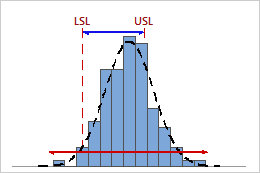
Low Cp
In this example, the specification spread is less than the overall process spread. Therefore, Cp is low (0.40) and the capability of the process is poor based on its variability.
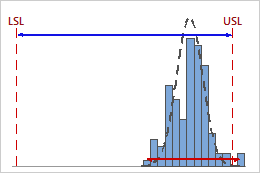
High Cp
In this example, the specification spread is considerably greater than the overall process spread. Therefore, Cp is high (1.80) and the overall capability of the process is good based on its variability.
-
Compare Cp to a benchmark value to assess the potential capability of your process. Many industries use a benchmark value of 1.33. If Cp is lower than your benchmark, consider how to improve your process by reducing its variation.
- Compare Cp and Pp. If Pp is considerably greater than Cp, there may be other sources of systemic variation in the process, in addition to the variation between and within the subgroups.
-
Compare Cp and Cpk. If Cp and Cpk are approximately equal, then the process is centered between the specification limits. If Cp and Cpk differ, then the process is not centered.
Caution
Because the Cp index does not consider the process location, it does not indicate how close the process is to the target region that is defined by the specification limits. For example, the following graphs show two processes with the same Cp value, yet one process falls within the specification limits and the other does not.
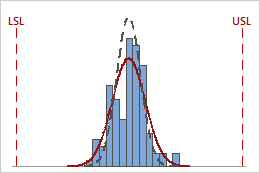
Cp = 3.13
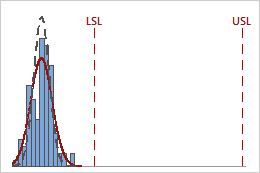
Cp = 3.13
For a complete and accurate analysis, use graphs in combination with other capability indices (such as Cpk) to draw meaningful conclusions from your data.
CPL (Between/Within)
- The distance from the process mean to the lower specification limit (LSL)
- The one-sided spread of the process (the 3-σ variation) based on the between/within standard deviation
Interpretation
Use CPL to evaluate the between/within capability of your process relative to the lower specification limit. Between/within capability indicates the capability that your process could achieve if systemic sources of process variation, besides the variation within and between the subgroups, were eliminated.
Generally, higher CPL values indicate that the process is capable at the lower tail of its distribution. Lower CPL values indicate that your process may need improvement.
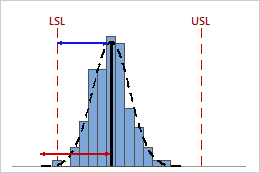
Low CPL
In this example, the distance from the process mean to the lower specification limit (LSL) is less than the one-sided process spread. Therefore, CPL is low (0.66) and the between/within capability of the process is poor in relation to its lower specification limit.
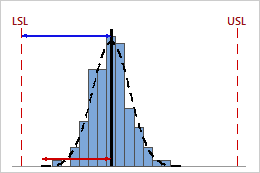
High CPL
In this example, the distance from the process mean to the lower specification limit (LSL) is greater than the one-sided process spread. Therefore, CPL is high (1.68) and the between/within capability of the process is good in relation to its lower specification limit.
-
Compare CPL with a benchmark value to assess the potential capability of your process. Many industries use a benchmark value of 1.33. If CPL is lower than your benchmark, consider ways to improve your process, such as reducing its variation or shifting its location.
-
If you have both lower and upper specification limits, compare CPL with CPU. If CPL does not approximately equal CPU, the process is not centered.
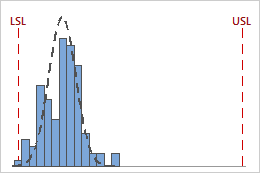
CPL = 0.92, CPU = 4.37
When CPL < CPU, the process is more likely to produce defective units that violate the lower specification limit.
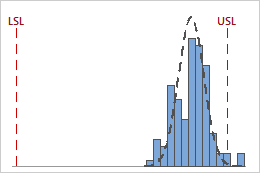
CPL = 4.37, CPU = 0.92
When CPU < CPL, the process is more likely to produce defective units that violate the upper specification limit.
CPU (Between/Within)
- The distance from the process mean to the upper specification limit (USL)
- The one-sided spread of the process (the 3-σ variation) based on the variation between/within standard deviation
Interpretation
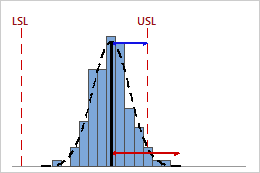
Low CPU
In this example, the distance from the process mean to the upper specification limit (USL) is less than the one-sided process spread. Therefore, CPU is low (0.66) and the between/within capability of the process is poor in relation to its upper specification limit.
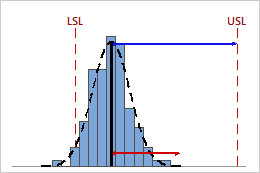
High CPU
In this example, the distance from the process mean to the upper specification limit (USL) is considerably greater than the one-sided process spread. Therefore, CPU is high (2.76) and the between/within capability of the process is good in relation to its upper specification limit.
-
Compare CPU with a benchmark value to assess the potential capability of your process. Many industries use a benchmark value of 1.33. If CPU is lower than your benchmark, consider ways to improve your process, such as reducing its variation or shifting its location.
-
If you have both lower and upper specification limits, compare CPL with CPU. If CPL does not approximately equal CPU, the process is not centered.

CPL = 0.92, CPU = 4.37
When CPL < CPU, the process is more likely to produce defective units that violate the lower specification limit.

CPL = 4.37, CPU = 0.92
When CPU < CPL, the process is more likely to produce defective units that violate the upper specification limit.
Cpk (Between/Within)
- The distance from the process mean to the closest specification limit (USL or LSL)
- The one-sided spread (the 3-σ variation) of the process based on between/within subgroup standard deviation
Interpretation
Use Cpk to evaluate the between/within capability, considering both its location and spread. Between/within capability indicates the capability that your process could achieve if systemic sources of overall process variation, besides the variation within and between the subgroups, were eliminated.
Generally, higher Cpk values indicate a more capable process. Lower Cpk values indicate that your process may need improvement.

Low Cpk
In this example, the distance from the process mean to the nearest specification limit is less than the one-sided process spread. Therefore, Cpk is low (0.66) and the between/within capability of the process is poor.

High Cpk
In this example, the distance from the process mean to the nearest specification limit is greater than the one-sided process spread. Therefore, Cpk is high (1.68) and the between/within capability of the process is good.
-
Compare Cpk with a benchmark that represents the minimum value that is acceptable for your process. Many industries use a benchmark value of 1.33. If Cpk is lower than your benchmark, consider ways to improve your process, such as reducing its variation or shifting its location.
- Compare Cpk and Ppk. If Cpk is considerably greater than Ppk, there may be other sources of systemic variation in the process, in addition to the variation between and within the subgroups. For example, tool wear is a systemic source of variation that could cause a manufacturing process to exhibit greater between/within capability (Cpk) than overall capability (Ppk).
-
Compare Cp and Cpk. If Cp and Cpk are approximately equal, then the process is centered between the specification limits. If Cp and Cpk differ, then the process is not centered.
Caution
The Cpk index represents only one side of the process curve, and does not measure how the process performs on the other side of the process curve.
For example, the following graphs display two processes with identical Cpk values. However, one process violates both specification limits, and the other process only violates the upper specification limit.

Cpk = min {CPL = 4.58, CPU = 0.93} = 0.93
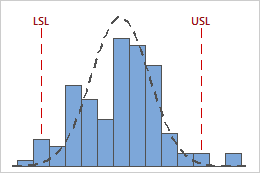
Cpk = CPL = CPU = 0.93
If your process has nonconforming parts that fall on both sides of the specification limits, consider using other indices, such as Z.bench, to more fully assess process capability.
Confidence interval (CI), Lower bound (LB), Upper bound (UB) for capability indices
The confidence interval is a range of likely values for a capability index. The confidence interval is defined by a lower bound and an upper bound. The bounds are calculated by determining a margin of error for the sample estimate. The lower confidence bound defines a value that the capability index is likely to be greater than. The upper confidence bound defines a value that the capability index is likely to be less than.
Note
To display confidence intervals, you must click Options and select Include confidence intervals when you perform the capability analysis. Minitab displays a confidence interval or a confidence bound for Cp, Pp, Cpk, Ppk, Cpm, and Z.bench.
Interpretation
Because samples of data are random, different samples collected from your process are unlikely to yield identical estimates of a capability index. To calculate the actual value of the capability index for your process, you would need to analyze data for all the items that the process produces, which is not feasible. Instead, you can use a confidence interval to determine a range of likely values for the capability index.
At a 95% confidence level, you can be 95% confident that the actual value of the capability index is contained within the confidence interval. That is, if you collect 100 random samples from your process, you can expect approximately 95 of the samples to produce intervals that contain the actual value of the capability index.
The confidence interval helps you to assess the practical significance of your sample estimate. When possible, compare the confidence bounds with a benchmark value that is based on process knowledge or industry standards.
For example, a company uses a minimum benchmark value of 1.33 for Ppk to define a capable process. Using capability analysis, they obtain a Ppk estimate of 1.46, which suggests that the process is capable. To further assess this estimate, they display a 95% lower confidence bound for Ppk. If the 95% lower confidence bound is greater than 1.33, they can be extremely confident that their process is capable, even when taking into account the variability from random sampling that affects the estimate.
Z.LSL for Between/Within Capability
Z.LSL (between/within) is the number of standard deviations between the process mean and the lower specification limit (LSL). It is calculated based on the between/within process performance, using the between/within subgroup standard deviation.
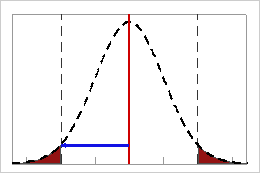
Note
To display Z.bench measures, you must click Options and change the default output from capability statistics to benchmark Z's when you perform the capability analysis.
Interpretation
Use Z.LSL (between/within) to evaluate the between/within sigma capability of your process relative to the lower specification limit.
Generally, higher Z.LSL values indicate that the process is capable at the lower tail of the distribution. Lower values indicate that your process may need improvement. When possible, compare Z.LSL (between/within) with a benchmark value based on process knowledge or industry standards. If Z.LSL is less than your benchmark, consider ways to improve your process.
Z.USL for Between/Within Capability
Z.USL (between/within) is the number of standard deviations between the process mean and the upper specification limit (USL). It is calculated based on the between/within process performance, using the between/within subgroup standard deviation.
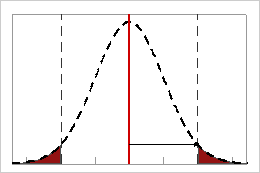
Note
To display Z.bench measures, you must click Options and change the default output from capability statistics to benchmark Z's when you perform the capability analysis.
Interpretation
Use Z.USL (between/within) to evaluate the between/within sigma capability of your process relative to the upper specification limit.
Generally, higher Z.USL values indicate that the process is capable at the upper tail of the distribution. Lower values indicate that your process may need improvement. When possible, compare Z.USL (between/within) with a benchmark value based on process knowledge or industry standards. If Z.USL is less than your benchmark, consider ways to improve your process.
Z.Bench for Between/Within Capability
Z.bench (between/within) is the percentile on a standard normal distribution that translates the estimated probability of defects in the process to an upper tail probability. It is calculated based on the between/within process performance, using the between/within standard deviation.
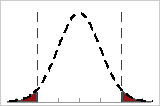
The defects for the process fall on either side of the specification limits. The between/within subgroup standard deviations are shown by the tick marks.
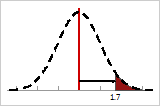
If you put all the defects on the right tail of the distribution, and then measure the number of between/within- subgroup standard deviations from the center (red line) to the point that defines the total defects, you obtain the Z-bench (between/within) value.
Note
To display Z.bench, you must click Options and change the default output from capability statistics to benchmark Z's when you perform the capability analysis.
Interpretation
Use Z.Bench (between/within) to evaluate the between/within sigma capability of your process.
Generally, higher Z.bench (between/within) values indicate that the process is more capable. Lower values indicate that your process may need improvement. When possible, compare Z.bench (between/within) with a benchmark value based on process knowledge or industry standards. If Z.bench (between/within) is less than your benchmark, consider ways to improve your process.
